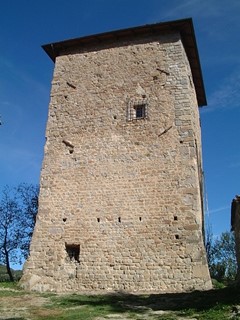Municipality of Lama Mocogno - Montecenere
After Pavullo, continuing along the Brenner state road (SS 12), and past the village of Lama Mocogno, we arrive at Montecenere.
The first mention we have of Montecenere is from the year 1180, however it appears that the village’s origins are much older. It served as an outpost for the surveillance, control and defence of the territory, symbolized by its imposing tower. Perched on the highest part of a mountainous spur, it undoubtedly formed part of a whole system of towers and fortifications to protect against the Lombards, who were ever ready to attack Frignano from Tuscany and to overwhelm the Byzantine defences at Ravenna.
The stone tower, built between the 12th and 13th centuries, rises from a substantial rectangular base measuring 7 by 8 metres with remarkably thick walls, which makes it conceivable that the original tower was considerably higher. There was no access to the ground floor from outside and the portal was raised in accordance with a tactical/defensive expedient commonly used by the Byzantines, and a characteristic of all the local medieval towers.
As testified by a document dated 1390, the fortalice complex was first entrusted by the Emperor, and later on by the Este, to the Montecuccoli family; however serious disagreements soon arose between the two feudatory cousins, Gaspare and Lanzillotto, which eventually led to the death of Lanzillotto and the violent taking of Montecenere by Gaspare, who became the undisputed lord of a vast fiefdom.
In those turbulent centuries, Montecenere was always considered a stronghold, one of the military strong points, along with Renno di Sopra and Montecuccolo, in the defence of central Frignano.
Its importance is demonstrated by the deeds of war which came to pass at the beginning of the 16th century, when the Pope’s armies entered the mountains near Modena to conquer them.
For the most part the troops laid siege to Montecenere and Sassostorno, and it was only the valour of the feudatories’ wives, the Countesses Camilla and Margherita, which prevented the Montecuccoli from being defeated ‒ something which would have been fatal for the Este family.
Later on, Montecenere became centre of the possessions of one of Frignano’s sons, Federico, who, despite living at the court of Ferrara, began redevelopment works around the tower erecting new buildings and a defensive wall.
Notarial documents record the 12 August 1677 as the date when the keys to the tower were handed to an emissary of General Raimondo Montecuccoli, who became the new owner of the fiefdom on the death of his cousin, Carlo. With the successive extinction of the Montecuccoli of Montecenere bloodline, the fortress changed hands several times and, over the centuries, fell into ruins. It was not until the 1700s that the first restoration works began, ending with definitive ones finished in 1998 which gave the tower its current appearance.
